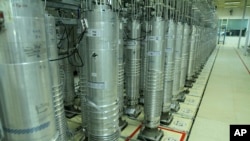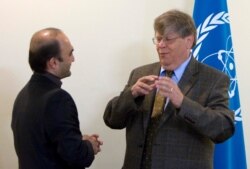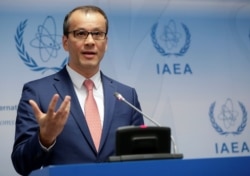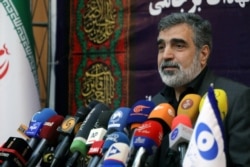A former IAEA official says diplomats working with the U.N. nuclear agency do not believe Iran’s apparent explanation for the presence of manmade uranium particles at a site in southern Tehran.
In a report published Monday, the IAEA said its inspectors monitoring Iranian compliance with commitments to curb potential weapons-related nuclear activities had “detected natural uranium particles of anthropogenic (manmade) origin at a location in Iran not declared to the agency.” The report, initially provided to IAEA member nations and later leaked to the media, did not identify the location of the particles or provide any other details about them.
In an interview with VOA Persian, former IAEA Deputy Director General Ollie Heinonen said diplomats of multiple countries working with the IAEA told him that the agency’s inspectors found the uranium particles at a southern Tehran site previously identified by Israel as the location of an alleged secret nuclear warehouse.
Heinonen, a nonproliferation analyst at the Washington-based Foundation for Defense of Democracies, said the diplomats gleaned the location of the particles from a Nov. 7 closed-door briefing in which IAEA Acting Director General Cornel Feruta discussed the report’s findings with the agency’s board of governors. The diplomats with whom Heinonen spoke were not Israelis, he added.
Israeli Prime Minister Benjamin Netanyahu first identified the compound in Tehran’s Turquzabad district in a September 2018 speech to the United Nations, calling it a “secret atomic warehouse for storing massive amounts of equipment and materiel from Iran’s secret nuclear weapons program.”
Iran, which insists its nuclear program always has been peaceful, denied the Israeli allegation and described Turquzabad site as private property. Israel has called on the international community to prevent Iran from developing nuclear weapons because of Iranian leaders’ repeated threats to destroy the Jewish state.
Heinonen cited his diplomatic sources as saying Iran told the IAEA that the uranium particles found by the inspectors at the Turquzabad compound were a contamination from scrapped equipment used at the Gchine uranium mine and mill near the southern port city of Bandar Abbas. Iran previously has declared to the IAEA that the Gchine site produces yellowcake, a refined form of raw uranium ore mined from the Earth’s crust.
Yellowcake can be further processed into enriched uranium to make fuel for nuclear power plants, Iran’s stated aim. It also can be refined to a high degree to provide material for nuclear bombs.
Heinonen said his sources dismissed Iran’s apparent explanation that equipment from the Gchine mine and mill was the source of the uranium particles at Turquzabad.
“The diplomats told me the IAEA Secretariat described the particles as having been converted from raw uranium without specifying their exact chemical form,” Heinonen said. “They said these particles were not from yellowcake but from something more refined.”
Neither the IAEA nor Iran have disclosed the nature of Iranian responses to IAEA questions about the uranium particles found by IAEA inspectors.
The IAEA did not respond to a VOA Persian request for comment about its communications with Iran. In its Nov. 11 report, the IAEA said: “It is essential for Iran to continue interactions with the agency to resolve this matter as soon as possible. On-going interactions … relating to Iran’s implementation of its Safeguards Agreement and Additional Protocol require full and timely cooperation by Iran.”
Israeli officials already had disclosed some of what Heinonen said he heard from his diplomatic sources about the uranium particles.
In a separate Nov. 7 briefing that followed the IAEA’s closed-door meeting on that date, unnamed Israeli security and intelligence officials told Western news agencies that IAEA inspectors found uranium particles in samples collected at the Turquzabad compound earlier this year.
The Israeli officials said the Turquzabad particles not only came from converted uranium that was not enriched, but also had characteristics that did not match any nuclear site previously disclosed by Iran. By contrast, Heinonen’s diplomatic sources only ruled out the Gchine mine and mill as a source of the particles. There was no word on how the Israeli officials reached their broader conclusion about the particles, a conclusion that pointed to their origin as being a secret Iranian nuclear conversion facility.
A spokesman for the Atomic Energy Organization of Iran (AEOI) appeared to confirm the Israeli assertion about the location of the uranium particles in remarks to reporters on Nov. 9, two days before the IAEA published its report revealing the discovery of those particles at an undeclared Iranian nuclear site.
Iranian state news agency ISNA quoted Behrouz Kamalvandi as saying there was “not a high degree” of nuclear “contamination” at Turquzabad. “Particles can fly and land anywhere,” he said, adding that such particles can be found in any country where IAEA inspectors operate. “It is not an important issue and is completely solvable,” Kamalvandi added.
Russia, an economic partner and military ally of Iran, also has tried to downplay the issue of the uranium particles. In a Wednesday report, Russia’s state-run Sputnik news agency cited Russian Deputy Foreign Minister Sergei Ryabkov as warning against “political hysteria” regarding uranium particles being found at an undeclared site in Iran.
But the United States, Israel’s top ally, said the IAEA’s Nov. 7 meeting about Iran raised issues that were “deeply troubling.” In a Nov. 8 statement, U.S. Secretary of State Mike Pompeo said: “Iran has no plausible explanation for the detected (nuclear) materials and must explain where these nuclear materials came from and where they are now.”
The IAEA has said Iran had an active program to develop a nuclear weapon until the end of 2003 and continued some related activities until as late as 2009. Israel has said documents it stole from a purported Iranian nuclear archive in Tehran in January 2018 show that Iran kept the option of restarting a nuclear weapons program in the future.
Iran has challenged the authenticity of those documents. Israel’s critics also have said there is no evidence of Iran engaging in weapons-related nuclear work since its 2015 deal with world powers to curtail sensitive Iranian nuclear activities in return for international sanctions relief. U.S. President Donald Trump withdrew from that deal last year, saying it did not do enough to prevent Iran from developing nuclear weapons and engaging in other malign behaviors.
This article originated in VOA’s Persian Service.










